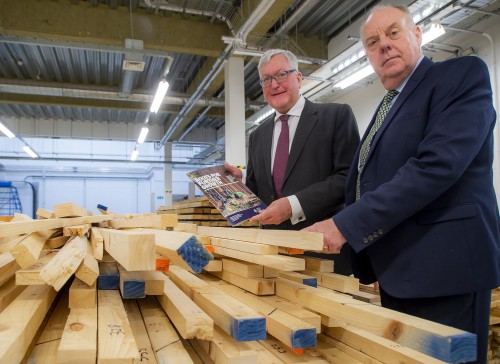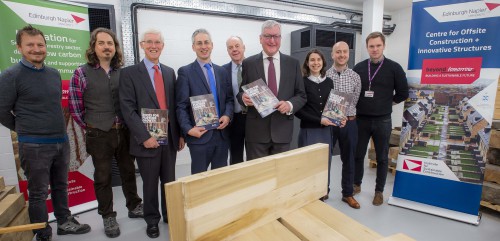Rural Economy Secretary tours facilities and hears of ambitious sector growth plans
Edinburgh Napier’s 7 Hills timber testing facility was the setting for today’s launch of a new forest industries strategy which aims to double the sector’s economic growth to £2billion a year by 2030.
The document was launched by the Scottish Forest and Timber Technologies Industry Leadership Group (ILG), on which the university is represented by Professor Sean Smith, who leads our Institute for Sustainable Construction.

ILG chair Martin Gale presented the strategy to Rural Economy Secretary Fergus Ewing, and they toured the university facility and witnessed the structural testing of potential new wood products.
Roots for Further Growth sets out a long-term vision for economic growth up to 2030. The strategy has five priorities
- Maximise the economic outputs of Scotland’s forest and fibre resource.
- Improve the safety and efficiency of the wood fibre supply chain.
- Expand markets and add value.
- Develop a workforce with skills for the future which supports inclusive growth.
- Understand and communicate the forest and wood-based industries’ contributions to Scotland’s economy.
Mr Gale said: “The potential of a sustainable natural material like wood fibre is an exciting one in a low carbon future world.”
Mr Ewing hailed the document an “ambitious and forward thinking strategy”.
He said: “The outputs of these forest industries are very important to Scotland, contributing significantly to our economic sustainable and inclusive growth in the rural economy and delivery of our climate change plans.
“In response to the healthy forecasts of increased wood fibre availability, the sector has invested heavily over the past 10 years to achieve world class wood processing facilities. This in turn has created many new jobs, often in the more fragile rural communities.”
The forest industries sector contributes significantly to Scotland’s climate change mitigation by sequestering carbon in sustainably managed forests. The timber used in construction also locks up carbon in wood products.

Roots for Further Growth covers the wide-ranging economic and business activities of the forest industries sector. This includes domestic and imported wood supply chains, engineered wood products and systems, recycled wood and wood energy. It also offers opportunities for new green industries such as wood-based biotechnologies
The strategy document references both Edinburgh Napier’s previous work and also planned industry engagement over the coming years. Professor Robert Hairstans and Associate Professor Dan Ridley-Ellis have been leading a series of industry projects.
Professor Hairstans said: “The research work of Edinburgh Napier will continue to shape the future of the sector, and we will work closely with industry and provide graduate opportunities.
“Our track record speaks for itself, as exemplified by our pioneering research on UK-resourced Cross Laminated Timber; large slabs of dimensional lumber capable of displacing the utilisation of carbon contributing materials such as concrete for medium and high-rise structures.”
Dr Ridley-Ellis added: “Forests are important for many reasons, and their ability to provide sustainable, environmentally friendly materials, and good employment in rural areas, will become even more crucial in the future bio-based circular economy.
“Our research, industry support, education, and standardisation work helped the development of the sector over the last decade and a half, and we are delighted to be part of the strategy towards 2030. We hope many other researchers will join us in our growing enthusiasm for forestry and timber.”